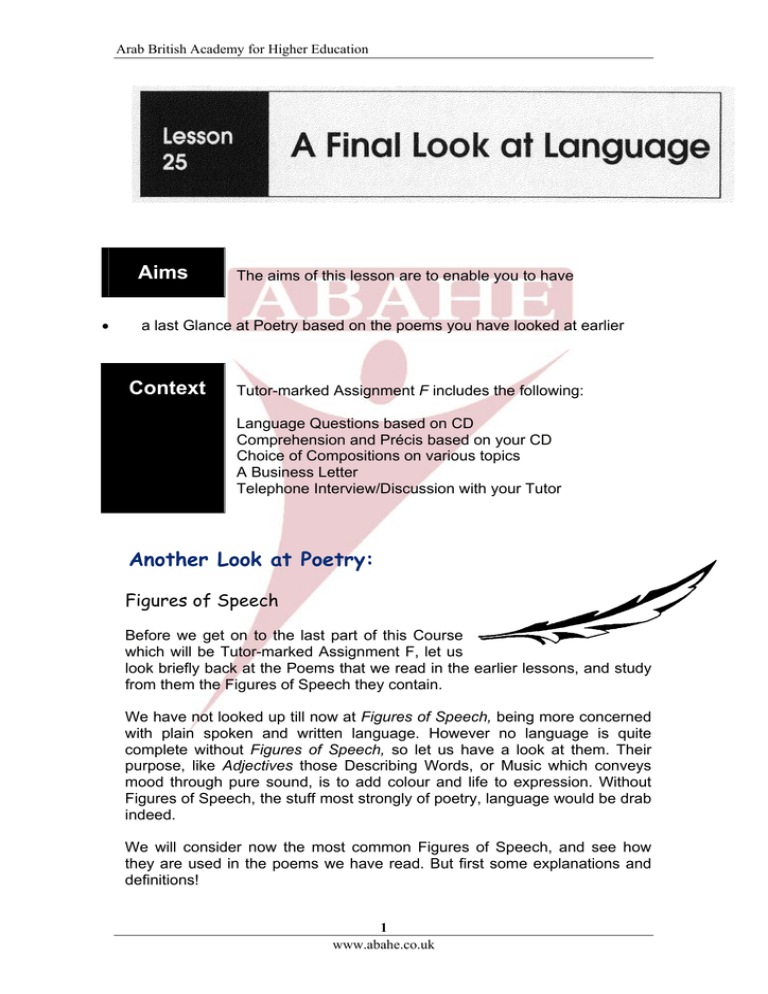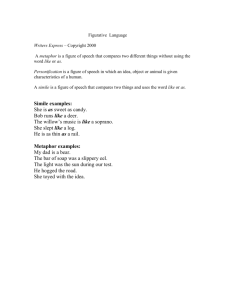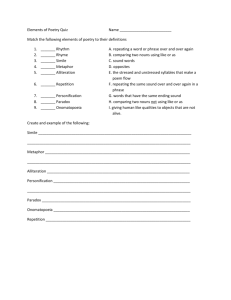
Arab British Academy for Higher Education
Aims
The aims of this lesson are to enable you to have
a last Glance at Poetry based on the poems you have looked at earlier
Context
Tutor-marked Assignment F includes the following:
Language Questions based on CD
Comprehension and Précis based on your CD
Choice of Compositions on various topics
A Business Letter
Telephone Interview/Discussion with your Tutor
Another Look at Poetry:
Figures of Speech
Before we get on to the last part of this Course
which will be Tutor-marked Assignment F, let us
look briefly back at the Poems that we read in the earlier lessons, and study
from them the Figures of Speech they contain.
We have not looked up till now at Figures of Speech, being more concerned
with plain spoken and written language. However no language is quite
complete without Figures of Speech, so let us have a look at them. Their
purpose, like Adjectives those Describing Words, or Music which conveys
mood through pure sound, is to add colour and life to expression. Without
Figures of Speech, the stuff most strongly of poetry, language would be drab
indeed.
We will consider now the most common Figures of Speech, and see how
they are used in the poems we have read. But first some explanations and
definitions!
1
www.abahe.co.uk
Arab British Academy for Higher Education
Metaphor:
This rather formidable looking expression is used to compare something with
another directly even though at first glance the two seem quite different.
Examples of Metaphor
a)
Shakespeare Richard Ill
“The king’s name was a tower of strength.”
(This means the king’s name has all the strength of a tower)
b)
“Now is the winter of our discontent
Made glorious summer by this sun of York”
Shakespeare: Richard III
(These famous lines at the beginning of Shakespeare’s History have not
only Metaphor (i.e. the use of “winter” and “summer” to describe war and
peace), but also the insertion of a kind of Pun (a play on words) “Sun of
York” referring to Edward the “Son of York”, (Richard Plantagenet), who was
recently crowned Edward IV.
Simile
The Simile is the other very widely used Figure of Speech: and compares
directly two very different things, using most often as or like for the
comparison. Here are some examples:
i) as good as gold (Proverb);
ii) March comes in like a lion and goes out like a lamb (Proverb);
iii) an’ the dawn comes up like thunder (Kipling)
Personification
There are other Figures of Speech like Personification, where an object is
given a person’s qualities or attributes, (e.g. in Shakespeare’s Sonnet XVIII,
the sun is called “the eye of heaven”) but these are not nearly as common as
Metaphor and Simile.
So let us have another look at the Poems we have presented and see what
Figures of Speech they contain; it is possible there will be others besides the
ones mentioned here.
Rapunzstiltskin: (Liz Lochead)
a)
Simile “... he hollered like a fireman in some soap opera” Comparison
b)
Metaphor “to weave the means of her own escape...”
Direct Comparison (“Skeins of silk.”)
c)
Simile “She was keener than a TV Quizmaster”
Comparison
2
www.abahe.co.uk
Arab British Academy for Higher Education
Over Hill - Over Dale (Shakespeare)
Simile:
“...swifter than the mooné’s sphere...”
Sigh No More, Ladies (Shakespeare)
Metaphor “One foot in sea, and one on shore”
Direct Comparison: showing unreliability of men...
Shall I compare thee to a summer’s day? (Shakespeare)
Simile “Shall I compare thee to a summer’s day?”
Comparison
Personification/Metaphor: “too hot the eye of heaven shines..”
(Here is an overlap between a Direct Comparison, and the giving to the Sun
of a Person’s Attributes...)
Metaphor: “But thy eternal summer shall not fade..”
(Direct Comparison)
Personification “Nor shall Death brag thou wanderest in his shade...“
(Death presented as a Person)
Activity 1
Please identify the Figures of Speech in the following Sentences:
and give the Meaning of the Image:
a) When Paul come in, he was like a bull in a china shop
b) Mary was simply a cat among the pigeons!
c) “Busy old fool, unruly sun!” Ben Jonson
d) Margaret Thatcher was known as “the Iron Lady”
e) The economic situation at the moment is quite bullish
f) The infection visited every house in the city
All Rights Reserved © Arab British Academy for Higher Education
3
www.abahe.co.uk







